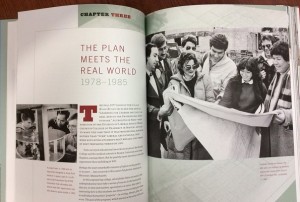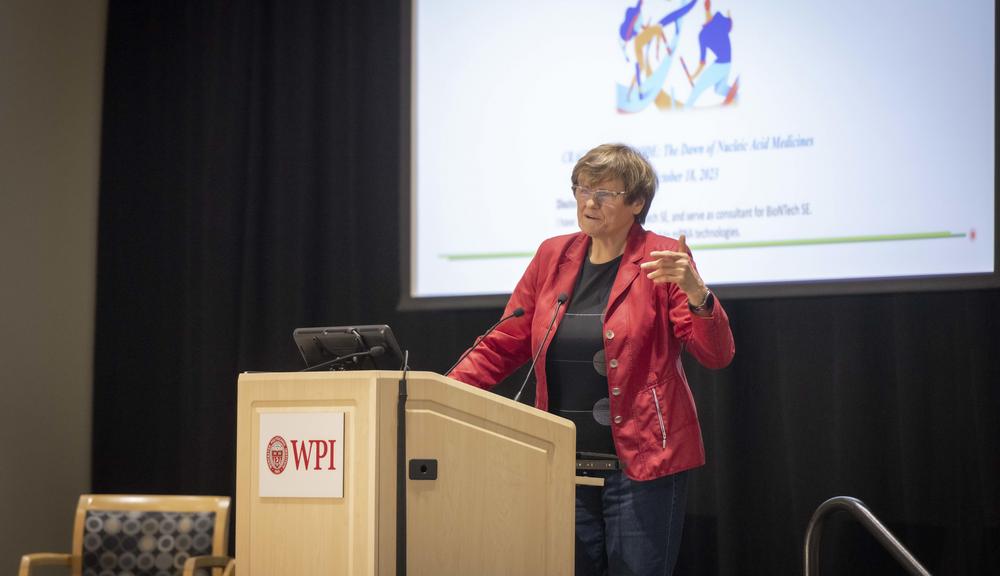The book offers a combination of historical facts, inspiring stories, and interesting details. True to its remit, it does not shy away from discussing darker and sometimes controversial issues, such as worries over accreditation and more than one financial crisis. Yet, it ultimately shows how the WPI community overcame these obstacles and did what does best—tackle and solve significant problems.
As Dorsey notes, nowhere are these struggles and achievements more apparent than with the development and implementation of the WPI Plan.
“Today we look at the WPI Plan as a revolutionary and highly successful initiative, but when a planning committee developed and brought it to a faculty meeting for a vote, one-third of the faculty actually voted against it,” says Dorsey.
 The book brings to life the actions by multiple university presidents, administrators, and faculty members who fought for the Plan’s ideals and helped put it into action and adapt it over several decades. It also touches upon related developments such as the arrival of WPI’s first female students, the rise of the Global Projects Program, the growth of the research enterprise, and the expansion of humanities and arts—all of which also faced significant hurdles.
The book brings to life the actions by multiple university presidents, administrators, and faculty members who fought for the Plan’s ideals and helped put it into action and adapt it over several decades. It also touches upon related developments such as the arrival of WPI’s first female students, the rise of the Global Projects Program, the growth of the research enterprise, and the expansion of humanities and arts—all of which also faced significant hurdles.
For example, the book details how one female student protested to no avail when her male peers held an annual Jell-O wresting event. In response, she wrote her IQP on the history and status of women on campus. A separate section provides a rundown of women’s athletics, from the time when women were forced to use hand-me-downs from men’s teams, to a spotlight on recent award-winning female athletes.
Regarding the global project program, Dorsey says, “Today’s students might be surprised to know that for many years, WPI struggled to attract students to its overseas programs.”
As the book notes, up until the mid-1990s, only 30 percent of students engaged in off-campus study. When administrators investigated further, they realized that many students were simply confused by many of the program’s logistics. In response, the student Global Ambassadors program was created, and applications doubled the following year.
HIDDEN DESIGN ELEMENTS AND QUIRKY DETAILS
Along with imparting the weighty history of the Plan, the book features hundreds of interesting images, as well as some amusing details. Its layout gives a nod to its predecessor, Two Towers, a history book published in 1965 that chronicles the first 100 years of WPI.
“True to Plan has larger dimensions than Two Towers, and the designer, Rick Rawlins, had the great idea to make the interior text blocks in True to Plan correspond to the actual size of Two Towers,” says Dorsey. “It’s a nice metaphor for how the events and ideals chronicled in the new book go beyond those in the former.”
Dorsey says that careful readers will also spot many details not covered in the book’s main text in its pictures, captions, and endnotes.
“There was so much information that we wanted to include that we decided to tell a whole different layer of stories through the photos and notes,” he says.
Just a few of the interesting details scattered throughout the book include these:
- Proposed alternatives to the Plan included WPI’s joining the state university system or becoming a high-level trade school.
- The first female students to live on campus were housed on first floor of Sanford Riley Hall and turned the washroom urinals into planters.
- An original component of the Plan, called Intersession, involved students taking special three-week courses in January, with topics including “Living in a Commune” and “Bachelor Cooking: Survival to Gourmet.”
- The Goat’s Head Pub, located where the Little Theatre is now, received a significant upgrade in 1974 when a group of undergraduate students remodeled it after Massachusetts lowered the drinking age from 21 to 18.
- WPI’s 13th president, Jon Strauss, arrived at WPI by traveling from Los Angeles to Worcester on a tandem bicycle with his wife, Jean.
Dorsey says the book offers an informative and inspiring read for all WPI community members—students, alumni, faculty, and staff.
“This is the type of book that people will want to sit down and read from cover to cover,” he says. “I hope that when they are finished they will not only have learned a lot but also feel proud to be part of WPI.”
– BY JENNIFER WYGLINSKI
 “We didn’t want to tell a story through rose-colored glasses,” says Mike Dorsey, WPI director of research communications and editor for the book. “We sought to give a real behind-the-scenes look at the struggles and triumphs that WPI went through as it transformed from a regional technical institute to a global model of innovation.”
“We didn’t want to tell a story through rose-colored glasses,” says Mike Dorsey, WPI director of research communications and editor for the book. “We sought to give a real behind-the-scenes look at the struggles and triumphs that WPI went through as it transformed from a regional technical institute to a global model of innovation.” The book brings to life the actions by multiple university presidents, administrators, and faculty members who fought for the Plan’s ideals and helped put it into action and adapt it over several decades. It also touches upon related developments such as the arrival of WPI’s first female students, the rise of the Global Projects Program, the growth of the research enterprise, and the expansion of humanities and arts—all of which also faced significant hurdles.
The book brings to life the actions by multiple university presidents, administrators, and faculty members who fought for the Plan’s ideals and helped put it into action and adapt it over several decades. It also touches upon related developments such as the arrival of WPI’s first female students, the rise of the Global Projects Program, the growth of the research enterprise, and the expansion of humanities and arts—all of which also faced significant hurdles.

